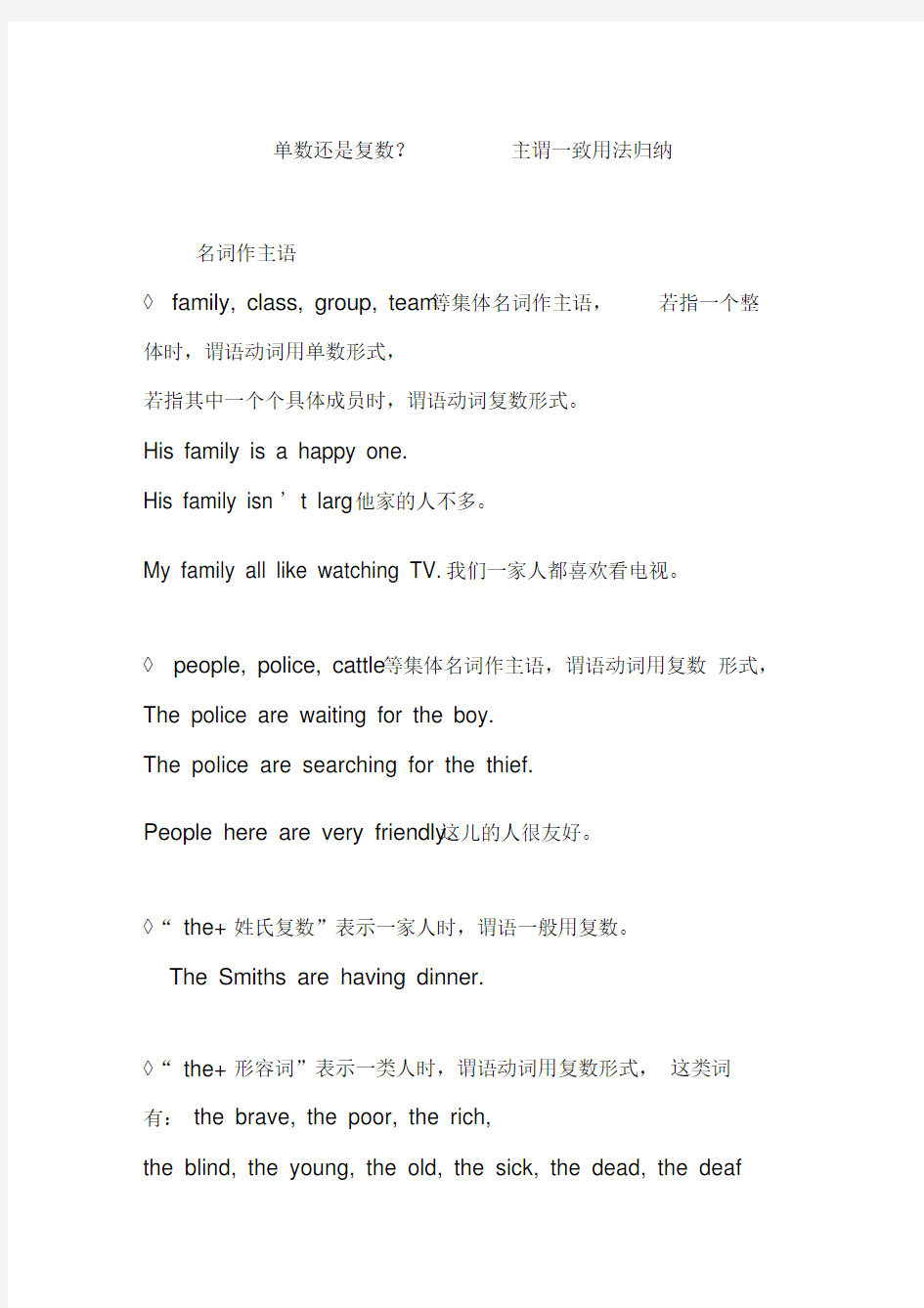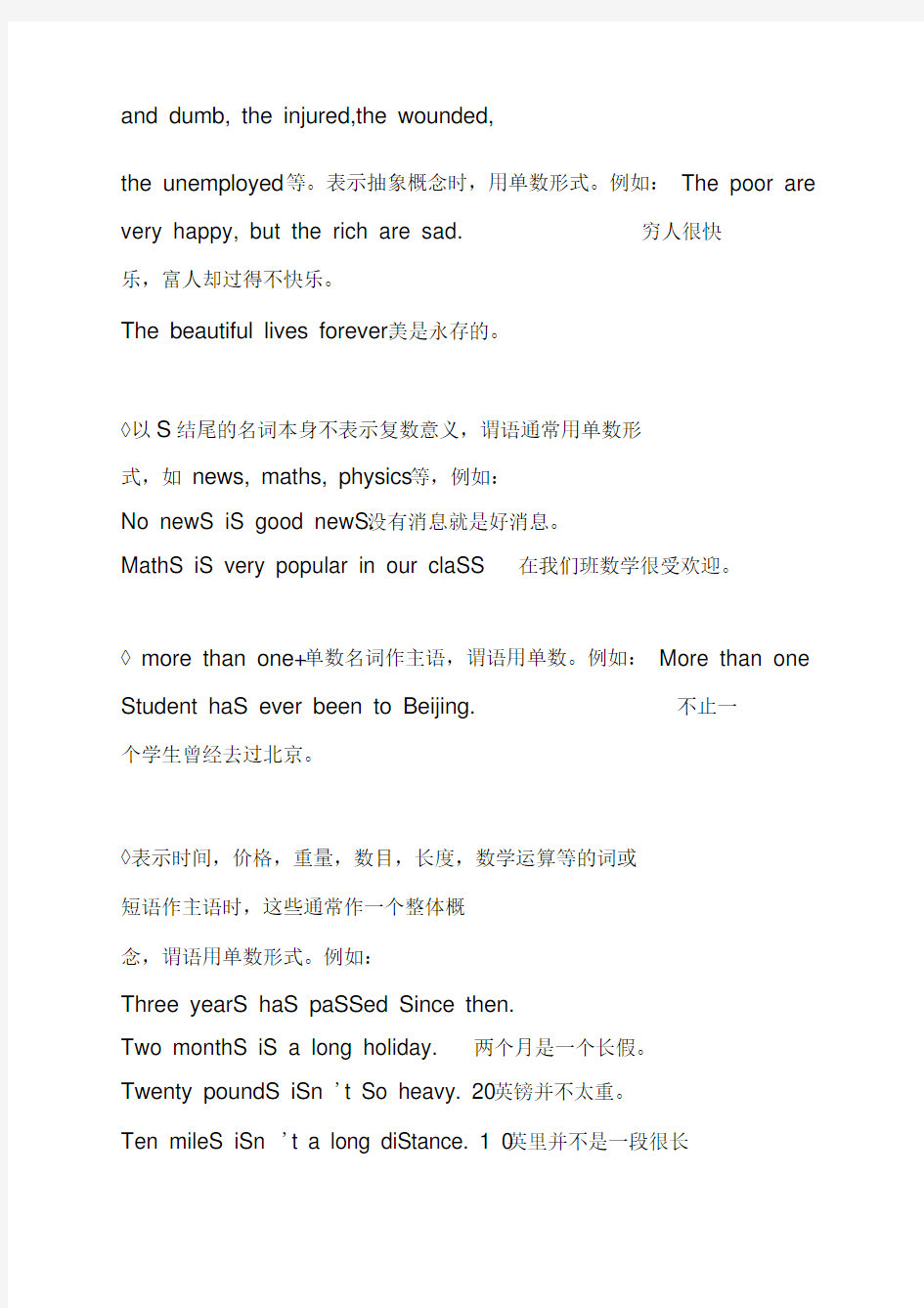“单数还是复数”——主谓一致用法归纳


单数还是复数?主谓一致用法归纳
名词作主语
?family, class, group, team 等集体名词作主语,若指一个整体时,谓语动词用单数形式,
若指其中一个个具体成员时,谓语动词复数形式。
His family is a happy one.
His family isn ' t larg他家的人不多。
My family all like watching TV. 我们一家人都喜欢看电视。
?people, police, cattle 等集体名词作主语,谓语动词用复数形式,The police are waiting for the boy.
The police are searching for the thief.
People here are very friendly. 这儿的人很友好。
?“ the+ 姓氏复数”表示一家人时,谓语一般用复数。
The Smiths are having dinner.
?“ the+ 形容词”表示一类人时,谓语动词用复数形式,这类词有:the brave, the poor, the rich,
the blind, the young, the old, the sick, the dead, the deaf
and dumb, the injured,the wounded,
the unemployed 等。表示抽象概念时,用单数形式。例如:The poor are very happy, but the rich are sad. 穷人很快
乐,富人却过得不快乐。
The beautiful lives forever. 美是永存的。
?以S结尾的名词本身不表示复数意义,谓语通常用单数形
式,如news, maths, physics 等,例如:
No newS iS good newS. 没有消息就是好消息。
MathS iS very popular in our claSS 在我们班数学很受欢迎。
?more than one+ 单数名词作主语,谓语用单数。例如:More than one Student haS ever been to Beijing. 不止一
个学生曾经去过北京。
?表示时间,价格,重量,数目,长度,数学运算等的词或
短语作主语时,这些通常作一个整体概
念,谓语用单数形式。例如:
Three yearS haS paSSed Since then.
Two monthS iS a long holiday. 两个月是一个长假。
Twenty poundS iSn 't So heavy. 20 英镑并不太重。
Ten mileS iSn 't a long diStance. 1 0 英里并不是一段很长
的距离。
Five minus four is one.
5减4 等于1
?a number of+ 复数名词作主语,谓语动词用复数;the number of + 复数名词作主语,谓语动词用
单数。例如:
A number of famous people were invited to party. 许多名
人都被邀请参加这个聚会。
The number of the students is over eight hundred. 我们学
校的学生数超过800 人。
A number of students have gone home.
The number of pages in this book is two hundred.
?动词不定式,动名词作主语时,谓语动词用单数形式。例如:
To see is to believe 眼见为实。
Doing eye exercises is good for your eyes. 做眼睛保健操对你的眼睛十分有益。
?主语为one of , each of, every one of, any one of 力口复数名
词或代词,谓语用单数。如:
One of my favorite sports is basketball.
Each of them has an English dictionary. 本英语词
典。 ?当kind of, pair of, glass of 等表示确定数量的名词短语修
饰主语时,谓语与 kind, pair, glass
等一致。例如:
This pair of shoes is Tom 这双鞋是汤姆的。
There are two glasses of water on the table. 桌上有两杯 水。
A pair of shoes was on the desk.
?“lots of/ a lot of/plenty of/ all/ most/ half / the rest of + 或“分数/百分数 +名词”作主语时, 谓语动词取决于名词的数;若是不可数名词,用单数;若名 词是复数,则用复数。这是因为短语中 后面的名词是中心词,而短语中前面的量词是修饰语。
Lots of damage was caused by fire.
water. Three-fifths of the workers here are women.
Most of his time is spent on study.
代词作主语
? none 与可数名词连用,谓语动词可用单数也可用复数,
none 如果代表不可数名词时谓语动
他们每人都有一
About three- fourths of the earth
词用单数。
None of the land has become desert. 这些土地都没有变成沙漠。
?不定代词somebody, someone, something, anybody, anything, everybody, everyone, everything,
nobody, no one, nothing 作主语,谓语动词用单数,例如:
Is everyone here today? 今天大家到齐了吗?
Something is wrong with him. 他有毛病。
Nobody was in. 没有人在家。
?疑问代词who, what, which 作主语时,如果说话人不知道具体的内容,谓语动词一般用单数。
Who lives next door?
What ' s in the bag?
并列结构作主语
?由both…and…连接两个单数名词作主语时,谓语动词用复数形式;
Both his father and his mother are both teachers.
他的爸
爸和妈妈都是老师。
?由and连接的两个名词作主语时,一般用复数形式。
Walking and riding are good exercises.
但and 所连接的并列主语是同一个人,谓语动词用单数,这时and 后面的名词没有冠词。如:
The writer and teacher is coming. 那位作家兼教师来了。
(作家和教师指同一个人)
The writer and the teacher are coming. 作家和老师来了。
(作家和老师是两个人)
and 前后的并列主语如果表示的是同一个概念,即前后合起来是一个整体,不可割裂开来,谓语动
词依然用单数形式。
Going to bed early and getting up early is a good habit.
A knife and fork is on the table.(刀叉和在一起才是完整的一副。)Too much work and too little rest often leads to illness. (9A
125)工作太多休息太少常常导致疾病。
?or, either ?…or ?…,neither ?…nor ?…,not only ?…but
also…,not…but…,连接两个名词或代词作主语时,
根据就近原则决定谓语动词形式。例如:
Tom or Jack is wrong. 不是汤姆就是杰克错了。
Either you or I am right. 要么你要么我是对的。
?当主语后面跟有with , together with , along with , as well as , besides ,except ,but,like,
including, in addition to, rather than 等词或介词短语时,谓
语动词由主语的单复数决定。例如:
Mike with his father has been to England. 迈克同他的父亲去过英格兰。Mike, like his brother, enjoys playing football 迈克像他的
哥哥一样喜欢踢足球。
The teacher as well as the students was reading in the
library.
与句式有关的主谓一致
?由what引导的主语从句,谓语动词通常用单数,但所指的
具体内容是复数意义时,谓语动词一
般用复数形式,例如:
What we need is more time.
What we need are doctors.
?在地点置于句首的倒装句中,谓语动词的数应与其后的主
语一致。如:
Here comes Simon.
Here are some books and paper for you. 这是给你的书和纸。Between the two windows hangs a picture.
